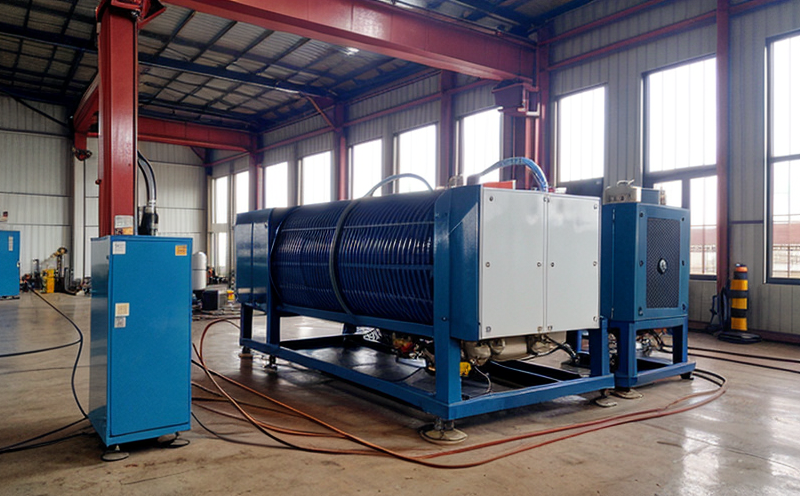Vibration monitoring system inspection
The vibration monitoring system inspection is a critical service within the broader context of energy systems and environmental surveillance. This inspection ensures that machinery and equipment are operating efficiently, safely, and in compliance with industry standards. By identifying potential issues early on, this service helps prevent costly downtime and extends the lifespan of assets.
At its core, vibration monitoring involves measuring the frequency, amplitude, and phase of oscillations within mechanical systems. This data is collected using sensors that are strategically placed across various components to capture a comprehensive picture of operational health. The collected data can then be analyzed to identify patterns indicative of wear and tear, misalignment, or other anomalies.
The importance of vibration monitoring cannot be overstated in today's energy landscape. With the increasing demand for reliability and sustainability, organizations are turning to predictive maintenance strategies that leverage advanced diagnostics like vibration analysis. This approach not only enhances operational efficiency but also contributes significantly to environmental conservation efforts by minimizing resource consumption and waste generation.
Our comprehensive inspection process begins with thorough pre-inspection preparations, including calibration of instruments and site surveys to understand the specific conditions under which equipment operates. During the inspection itself, our team utilizes state-of-the-art technology such as laser vibrometers, accelerometers, and sound level meters to gather precise measurements.
After collecting all necessary data points, our analysts employ sophisticated software tools to interpret results against established benchmarks from recognized standards like ISO 10816-1:2017. These standards provide clear guidelines on acceptable limits of vibration levels for different types of machinery based on their design characteristics and operating conditions.
The final step in this process involves generating detailed reports that summarize findings along with recommendations for corrective actions if any issues were detected during the inspection. Our clients benefit from actionable insights which allow them to prioritize maintenance tasks effectively while ensuring regulatory compliance.
Industry Applications
| Application Area | Description of Use |
|---|---|
| Data Centers | Vibration monitoring helps maintain optimal running conditions for IT equipment, preventing overheating and ensuring data integrity. |
| Wind Turbines | Identifies structural defects in blades or gearbox components before they lead to catastrophic failure. |
| Offshore Platforms | Ensures stable operation of critical components under harsh marine environments, enhancing safety and efficiency. |
| Manufacturing Plants | Lowers maintenance costs by predicting failures early, thereby optimizing production schedules. |
| Transportation Infrastructure | Monitors roadways, bridges, and rail systems for signs of fatigue or deterioration contributing to safer travel conditions. |
| Power Plants | Guarantees consistent performance levels across various power generation facilities, supporting sustainability goals. |
The versatility of vibration monitoring makes it applicable across numerous sectors. From ensuring robust performance in data centers to safeguarding marine assets on offshore platforms, this service plays an integral role in maintaining high standards throughout diverse industries.
Competitive Advantage and Market Impact
In a highly competitive market characterized by stringent regulatory requirements and ever-evolving technological advancements, adopting robust vibration monitoring practices can give organizations a significant edge. By staying ahead of potential problems through proactive measures, companies not only reduce operational risks but also enhance their reputation as reliable partners.
For quality managers striving to uphold the highest standards within their operations, implementing effective vibration monitoring systems represents a strategic investment in long-term success. It allows for better resource allocation by focusing efforts on areas where they are most needed rather than reacting to crises after they occur. Furthermore, adherence to international best practices ensures alignment with global trends and fosters trust among stakeholders.
Compliance officers benefit greatly from such services too as it facilitates easier tracking of compliance status regarding environmental laws related to noise pollution control or industrial hygiene regulations concerning worker safety. The ability to demonstrate proactive engagement towards these matters strengthens relationships with regulatory bodies and promotes a positive image within the community.
R&D engineers can leverage vibration monitoring data to refine designs continuously, leading to innovations that improve overall performance while reducing energy consumption. Meanwhile, procurement departments may find value in leveraging this information when selecting suppliers capable of delivering reliable products that meet stringent quality benchmarks.
In summary, embracing vibration monitoring systems inspection translates into tangible benefits for all parties involved—enhanced reliability, reduced costs associated with unplanned maintenance or repairs, improved safety measures, and increased efficiency—all contributing to a more sustainable future where technology meets environmental responsibility.
Use Cases and Application Examples
In the realm of industrial machinery, vibration monitoring plays an indispensable role in identifying subtle signs of degradation that could otherwise go unnoticed until catastrophic failures occur. For instance, in wind turbine installations, regular inspections using advanced vibration analysis techniques help detect early wear patterns on gearboxes or blade assemblies. Such insights enable operators to schedule maintenance at optimal intervals rather than waiting for complete failure, resulting in substantial savings both in terms of time and money.
Similarly, in the transportation sector, monitoring roadways and bridges for signs of fatigue is crucial given the constant exposure these structures face from traffic loads and weather conditions. Vibration sensors deployed along key routes provide real-time feedback on structural integrity, allowing authorities to prioritize repairs before they lead to accidents or costly replacements.
Manufacturing plants also stand to gain immensely by integrating vibration monitoring into their maintenance protocols. By continuously tracking the performance of critical machinery such as presses and conveyors, manufacturers can anticipate impending failures well in advance, thus minimizing disruptions to production schedules. Additionally, this proactive approach ensures compliance with stringent environmental regulations governing emissions from industrial processes.
For power generation facilities, especially those operating large-scale plants like nuclear reactors or thermal power stations, vibration monitoring serves multiple purposes. It aids in maintaining optimal performance levels while simultaneously safeguarding against safety hazards posed by overheating components or misaligned turbines. Moreover, this information is vital for aligning operations with broader sustainability goals aimed at reducing carbon footprints and promoting cleaner energy solutions.





